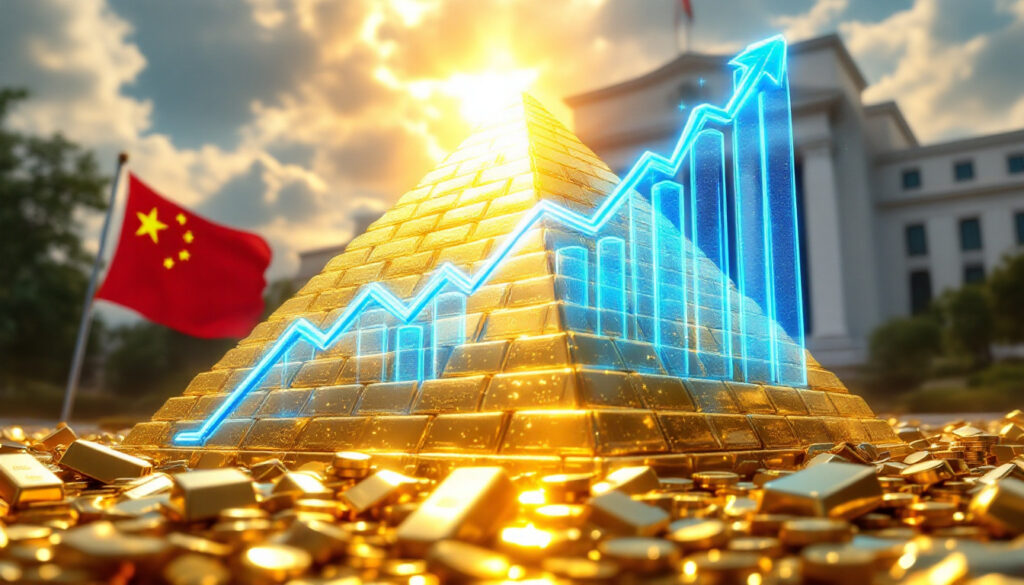What's Driving the Recent Rally in Gold Prices?
The interplay between gold prices and Federal Reserve policy decisions has reached a critical juncture, with recent market movements reflecting complex macroeconomic forces. Gold surged 2.65% to $3,422.60, its highest level in two weeks, driven by post-holiday buying in China and strategic expansions by the Shanghai Gold Exchange. Concurrently, the Federal Reserve's policy meeting has intensified scrutiny over interest rates, with 96% of market participants anticipating no change, though a minority 3% foresee a potential cut.
Chinese Market Influence on Gold Rally
The reopening of Chinese markets after the Labor Day holiday (May 1–5) catalyzed a 2.65% surge in gold prices to $3,422.60, as retail investors resumed large-scale purchases. Record trading volumes at the Shanghai Gold Exchange underscore China's dominance as the world's largest gold consumer, with retail activity contributing to 40% of global physical demand in Q1 2025.
This surge reflects growing confidence in gold as a wealth preservation asset among Asian investors, particularly as concerns about real estate market stability and potential currency devaluation persist in the region.
Shanghai Gold Exchange's Strategic Expansion
The Shanghai Gold Exchange's plan to establish a Hong Kong warehouse, operated by the Bank of China, aims to institutionalize yuan-denominated gold benchmarking. This strategic move represents a significant shift in the global commodity markets structure, potentially challenging Western market dominance.
"By centralizing storage and settlement in Hong Kong, Beijing seeks to mitigate currency volatility and assert control over pricing mechanisms, aligning with its broader digital yuan initiatives."
Yuan-backed contracts now account for 22% of global gold trading, up from 12% in 2023—a substantial increase that demonstrates China's growing influence in precious metals markets.
Record Trading Volumes in Chinese Markets
Retail investors in China traded an impressive 1,850 metric tons of gold in Q1 2025, representing a 30% increase from the previous quarter. This surge has been driven by:
- Uncertainties in the Chinese real estate market
- Fears about potential currency devaluation
- Increased accessibility of gold investment products
- Growing perception of gold as a stable store of value
The Shanghai Futures Exchange reported a 25% month-over-month rise in gold derivatives trading, reflecting leveraged speculation on further price appreciation and indicating strong bullish sentiment among Chinese investors.
How Are Other Precious Metals Performing?
Silver Market Performance and Outlook
Silver has reclaimed the $33 mark, rising 2.14% to $33.27, though it underperformed gold due to weaker industrial demand. While maintaining its position above key psychological price levels, silver's performance remains influenced by both its monetary and industrial characteristics.
Photovoltaic sector demand, which accounts for 20% of silver consumption, grew only 5% in 2025 compared to 12% in 2024, dampening bullish sentiment. However, its monetary appeal persists, with ETF holdings increasing by 8% since January.
The metal's dual nature—as both an industrial material and a monetary asset—creates unique market dynamics that often result in higher volatility compared to gold, particularly during periods of economic uncertainty.
Platinum and Palladium Market Movements
Platinum rose 2.4% to $1,000, buoyed by supply constraints in South Africa, where mining output declined by 12% due to energy shortages. The metal faces continued challenges related to:
- Persistent electricity supply issues affecting major mining operations
- Labor disputes in key production regions
- Shifting demand patterns in the automotive industry
- Competition from alternative materials in certain applications
Palladium outperformed with a 3.5% gain to $1,015, as automakers stockpiled the metal ahead of stricter emissions standards in the European Union. This price movement reflects broader strength across the precious metals complex and suggests systemic factors affecting the entire sector rather than metal-specific catalysts.
What Role Does the Federal Reserve Play in Gold Price Movements?
Federal Reserve Policy Meeting Expectations
The Federal Open Market Committee (FOMC) maintained rates at 5.25–5.50%, aligning with 96% of market expectations. This decision came amid continued scrutiny of inflation data and economic growth indicators.
Chair Jerome Powell's acknowledgment of "elevated inflation risks" triggered a 1.2% intraday gold price swing, highlighting the metal's sensitivity to forward guidance and the market's vigilance regarding potential monetary policy shifts.
Market Reaction to Potential Fed Decisions
The U.S. Dollar Index (DXY) fell 0.5% to 99.23, amplifying gold's appeal as a hedge against currency depreciation. This decline provided additional support for precious metals prices, as gold typically exhibits an inverse relationship with the dollar.
Futures markets priced in a 45% probability of a September rate cut, up from 30% pre-meeting, reflecting concerns over Q2 GDP growth slowing to 1.8%. This changing market sentiment illustrates how closely investors monitor Fed communications for clues about future policy direction.
Interest Rate Trajectory and Gold Price Correlation
Gold's 120-day inverse correlation with real yields tightened to -0.78, its strongest since 2020, as breakeven inflation rates climbed to 2.6%. This correlation highlights gold's traditional role as a hedge against economic instability and inflation concerns.
Historical analysis shows a 1% Fed rate cut typically generates a 14% gold price increase over six months, suggesting significant upside potential if dovish signals emerge.
This relationship between monetary policy and precious metals prices continues to reinforce gold's appeal during periods of economic uncertainty and accommodative central bank policies.
How Are Global Economic Factors Influencing Precious Metals?
Dollar Index Weakness and Safe-Haven Demand
The DXY's 7% decline from its 2024 peak has enhanced gold's affordability for Euro and yen-based investors, with EU gold imports rising 18% year-to-date. When the US currency weakens, dollar-denominated gold becomes more affordable for holders of other currencies.
Escalating U.S.-China trade tensions over pharmaceutical tariffs contributed to $2.8 billion in gold ETF inflows during May. These geopolitical factors have increased market uncertainty, prompting investors to allocate more capital to precious metals as a portfolio diversification strategy.
BRICS Nations' Gold Market Impact
Upcoming BRICS summit agendas include proposals for a commodity-backed trade settlement system, potentially expanding gold's role in bypassing dollar transactions. This development could significantly alter global monetary dynamics and enhance gold's international standing.
Russia and China have increased bilateral gold & silver investments outlook by 40% since 2023, signaling de-dollarization efforts. These strategic moves by major economies reflect growing concerns about the current international monetary framework and suggest preparations for potential changes to the global financial system.
What Are the Technical Indicators Suggesting?
Support Levels and Correction Risks
Gold's break above $3,400 established new support, with the 50-day moving average converging at $3,350. This technical development provides a foundation for continued bullish momentum, though short-term volatility remains likely.
However, the Relative Strength Index (RSI) of 72 indicates overbought conditions, heightening short-term correction risks. After significant price increases, corrective pullbacks may occur as shorter-term futures traders realize gains, potentially creating temporary price dips within the broader upward trend.
The current technical configuration suggests a potential consolidation phase before any renewed upward movement:
| Technical Indicator | Current Level | Implication |
|---|---|---|
| RSI | 72 | Overbought conditions |
| 50-Day MA | $3,350 | Key support level |
| 200-Day MA | $3,100 | Long-term trend support |
| MACD | Positive but narrowing | Momentum slowing |
Long-Term Outlook and Institutional Positioning
Managed money net long positions in gold futures reached 250,000 contracts, nearing all-time highs, while central banks added 800 tons to reserves in 2025's first quarter. This substantial institutional positioning underscores the strong fundamental support for gold prices.
Structural demand suggests a bullish multi-year trend, with Citi forecasting $3,800/oz by 2026. Despite potential short-term fluctuations, the fundamental outlook for gold remains positive from a wealth preservation perspective, supported by central bank buying, inflation concerns, and geopolitical tensions.
How Are Central Banks Influencing the Market?
Diversification Strategies and Gold Purchases
Central banks purchased an impressive 1,100 tons of gold in 2024, the second-highest annual total, led by Turkey (160 tons) and India (95 tons). This ongoing trend of central banks seeking to reduce exposure to US assets, particularly the dollar, has contributed to sustained demand for gold.
The People's Bank of China increased holdings by 8% to 2,250 tons, diversifying from U.S. Treasuries, which fell to 28% of reserves. This diversification strategy reflects concerns about US fiscal policies and the long-term stability of the dollar as the world's reserve currency.
Implications for Monetary Systems
Gold's share of global reserves rose to 15%, up from 11% in 2020, as nations hedge against potential IMF SDR reforms. This shift indicates growing concerns about the current international monetary framework and suggests preparations for potential changes to the global financial system.
The Basel III accord's treatment of gold as a Tier 1 asset further incentivizes institutional accumulation, providing regulatory support for central banks to increase their gold holdings without capital penalties.
FAQ: Gold Prices and Federal Reserve Policy
How do Federal Reserve interest rate decisions affect gold prices?
Interest rate decisions directly impact gold prices because gold doesn't yield interest. When rates remain low or decrease, the opportunity cost of holding non-yielding assets like gold diminishes, making it more attractive to investors. Conversely, when rates rise, interest-bearing assets become more competitive, potentially reducing gold's appeal. The current gold price analysis shows market expectations for stable or potentially lower rates have contributed to gold's positive price momentum.
Why is China's role in the gold market significant?
China's influence on gold markets is substantial due to its position as both the world's largest gold producer and one of the top consumers. The Shanghai Gold Exchange's plans to expand its warehouse network and promote yuan-denominated gold benchmarking represents a strategic move to gain greater control over global gold pricing mechanisms. This shift could potentially challenge the London and New York markets' traditional dominance in setting international gold prices.
What factors might cause gold prices to pull back in the near term?
Several factors could trigger a corrective pullback in gold prices:
- Profit-taking by short-term traders following significant price increases
- Unexpected hawkish signals from the Federal Reserve
- Strengthening of the US dollar
- Reduced geopolitical tensions
- Technical selling pressure after reaching overbought conditions
Technical analysts suggest that after rapid price advances, consolidation phases are normal and healthy for sustainable long-term uptrends in precious metals markets.
How do physical gold purchases compare to paper gold investments?
The comparison between physical and paper gold has several important dimensions:
| Aspect | Physical Gold | Paper Gold (ETFs, Futures) |
|---|---|---|
| Ownership | Direct possession | Financial instrument |
| Counterparty Risk | Minimal | Present |
| Storage | Required (costs involved) | Not required |
| Liquidity | Less liquid | Highly liquid |
| Premium/Discount | May trade at premium during crises | Tracks spot price more closely |
Many long-term investors prefer physical ownership for wealth preservation, while traders may utilize gold ETFs guide for short-term positioning.
Conclusion
The gold market analysis shows record prices reflect convergent macroeconomic forces: aggressive central bank buying, dollar weakness, and geopolitical realignments. While Federal Reserve hawkishness poses short-term risks, structural demand drivers and BRICS-led de-dollarization efforts suggest sustained upward pressure on gold prices and Federal Reserve meeting outcomes will continue to play a crucial role in market dynamics.
Investors should monitor Shanghai Gold Exchange innovations and Fed inflation targeting revisions, which may redefine gold's role in the international monetary system over the coming decade, according to Reuters' recent market analysis and Kitco's latest market updates.
Disclaimer: This analysis contains forward-looking statements about gold prices and Federal Reserve policy. Such predictions involve inherent uncertainty and should not be considered as financial advice. Always consult with a licensed financial advisor before making investment decisions.
Ready to Spot the Next Major Mineral Discovery?
Get instant alerts on significant ASX mineral discoveries through Discovery Alert's proprietary Discovery IQ model, turning complex market data into actionable investment insights. Understand why historic discoveries can generate substantial returns by visiting Discovery Alert's dedicated discoveries page and begin your 30-day free trial today.




